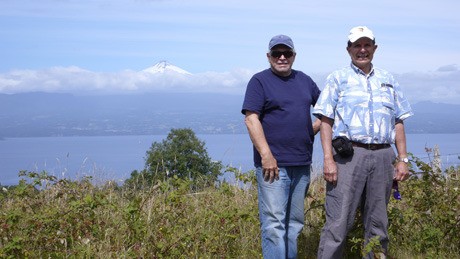Early on the morning of Feb. 27, Islander Paul Calderon was asleep, staying with friends in the lakefront town of Villarrica, Chile, just 120 miles southwest of the city of Concepcion.
He awoke at 3:45 a.m., his bed moving back and forth. He lay still for several seconds, wondering if he should get up and out.
“All I could think,” he said, “is I hope this house holds together.”
But then the shaking and swaying got worse.
He remembers vividly what happened next: “I jumped out of bed, put my shoes on and went to a doorway when motion rapidly got violent, slamming back and forth. The house was swaying from left to right more than a foot in each direction, and I could hear the timbers creaking and things crashing onto the floor, glass breaking and lots of noise downstairs during the quake, which lasted at least two minutes. Outside, large oak trees were swaying as if in a strong windstorm, except it was perfectly still!”
It was loud, he said. As loud as loud music.
Within the groaning and straining of the structure, he heard a large book case in the main room fall over; dishes and spice bottles in the kitchen tumbled off counters and shelves; the venetian blinds kicked and clanged back and forth on the windows.
When the shaking finally stopped, Calderon said that he and the other people in the house gathered in the main room to look over the damage and check on each other.
There were nine people in the 7,000-square-foot house. Yet no one made a sound, he said. No one screamed or cried out. But there was more to come.
“Right after the violent motion stopped, the lake sloshed out of its banks about 30 feet. In the dark, the whooshing sound of the water reminded us all of a strong wind.
Later they found that many neighbors had lost their docks, boats had broken free and floated away, but fortunately no one (most of them cousins and relatives of his host) on their side of the lake suffered structural damage to their homes.
Calderon is no stranger to South America and its sporadic shaking.
Calderon was born in Chicago in 1943. His mother was from Spokane, Wash., the daughter of a Methodist minister, and his father, a physician, was a native of Peru. In 1946, the family moved back to Peru where Calderon stayed until he turned 18 and returned to the United States for college.
Despite having lived at the foot of the Andes Mountains, as well as the quake-prone Puget Sound for many years, Calderon said the Feb. 27 quake was an earthquake like no other.
The largest earthquake ever instrumentally recorded occurred in Chile in 1960. The Feb. 27 quake is said to be the second largest ever. Calderon was living in South America in 1960, as were his hosts, who said that the February 8.8 quake was the largest they had ever experienced.
The house where Calderon stayed was built by his host, Raul Diaz, specifically to withstand such shaking. Diaz, who holds an engineering degree from the United States, built the structure out of the native hardwood logs from his own land. The logs are attached with steel bands and bolted to a concrete foundation. During the quake, the building only suffered a broken window or two and a couple of cracks.
The power went off during the quake at the home, but visitors were able to gain Internet access on their battery-powered laptops and contact relatives back in the United States. Power came back after two days. The main house and most of those in the nearby neighborhood were intact; there was food and water, and relatively little damage.
“We felt guilty,” Calderon said. “We could see the damage in Concepcion and Santiago on the television. Here we were with food, water and shelter.”
Aftershocks continued throughout the next several days, he said. Some as powerful as 6.7.
“Everyone was a bit disoriented. There is a sadness and worry,” he said. “When you felt another quake, you would think, ‘Oh, not again.’”
There was consolation in the fact that the damage from the earthquake was contained to areas around the epicenter. The most devastating damage was from the tsunami that followed the quake. Yet many key pieces of infrastructure were affected. One man staying at the house needed to catch his flight from Santiago just a couple of days after the quake. It took 24 hours by car instead of the usual nine.
When Calderon flew from Santiago to the United States on March 17, almost three weeks after the quake, at least one terminal at the airport had been deemed too dangerous for passengers. It had been shut down with operations moved outdoors under tents. But despite the difficulties, the airport and flights operated smoothly.
Calderon emphasized that the country he knows is well prepared for earthquakes. Building codes and engineering standards, and the fact that most buildings are built with wood, kept the area somewhat protected from extreme damage. Yet many need help, Calderon said. Highways and hospitals were affected. Many are in need.
Calderon, now retired, worked for companies such as Sun Microsystems and Phillips Medical Systems as a financier who arranged for client financing to purchase large, high-tech medical diagnostic and computer systems.
Despite moving here in 1988 with his wife, Wanda, who died in 2007, Calderon has spent much of his life traveling and working throughout the world. He has no doubt that he will return to stay with his friends in Chile in the future.


